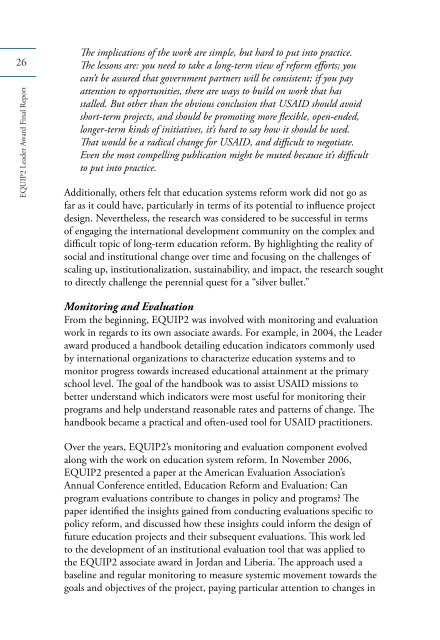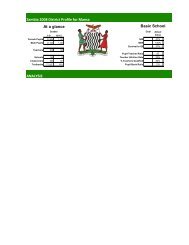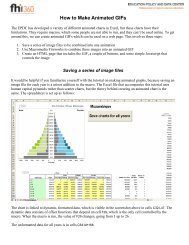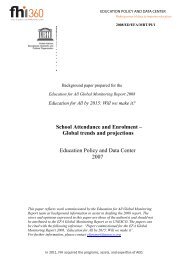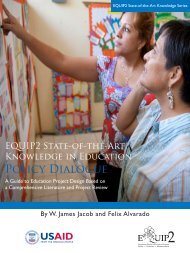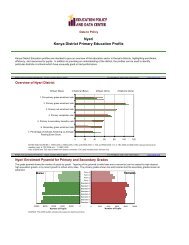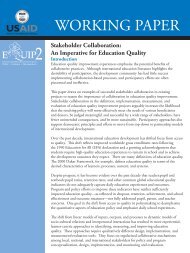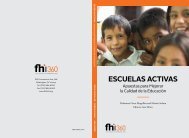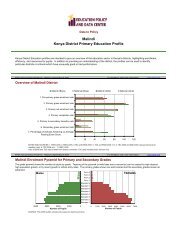EQUIP2 Final Report.pdf - Education Policy Data Center
EQUIP2 Final Report.pdf - Education Policy Data Center
EQUIP2 Final Report.pdf - Education Policy Data Center
Create successful ePaper yourself
Turn your PDF publications into a flip-book with our unique Google optimized e-Paper software.
26<br />
<strong>EQUIP2</strong> Leader Award <strong>Final</strong> <strong>Report</strong><br />
The implications of the work are simple, but hard to put into practice.<br />
The lessons are: you need to take a long-term view of reform efforts; you<br />
can’t be assured that government partners will be consistent; if you pay<br />
attention to opportunities, there are ways to build on work that has<br />
stalled. But other than the obvious conclusion that USAID should avoid<br />
short-term projects, and should be promoting more flexible, open-ended,<br />
longer-term kinds of initiatives, it’s hard to say how it should be used.<br />
That would be a radical change for USAID, and difficult to negotiate.<br />
Even the most compelling publication might be muted because it’s difficult<br />
to put into practice.<br />
Additionally, others felt that education systems reform work did not go as<br />
far as it could have, particularly in terms of its potential to influence project<br />
design. Nevertheless, the research was considered to be successful in terms<br />
of engaging the international development community on the complex and<br />
difficult topic of long-term education reform. By highlighting the reality of<br />
social and institutional change over time and focusing on the challenges of<br />
scaling up, institutionalization, sustainability, and impact, the research sought<br />
to directly challenge the perennial quest for a “silver bullet.”<br />
Monitoring and Evaluation<br />
From the beginning, <strong>EQUIP2</strong> was involved with monitoring and evaluation<br />
work in regards to its own associate awards. For example, in 2004, the Leader<br />
award produced a handbook detailing education indicators commonly used<br />
by international organizations to characterize education systems and to<br />
monitor progress towards increased educational attainment at the primary<br />
school level. The goal of the handbook was to assist USAID missions to<br />
better understand which indicators were most useful for monitoring their<br />
programs and help understand reasonable rates and patterns of change. The<br />
handbook became a practical and often-used tool for USAID practitioners.<br />
Over the years, <strong>EQUIP2</strong>’s monitoring and evaluation component evolved<br />
along with the work on education system reform. In November 2006,<br />
<strong>EQUIP2</strong> presented a paper at the American Evaluation Association’s<br />
Annual Conference entitled, <strong>Education</strong> Reform and Evaluation: Can<br />
program evaluations contribute to changes in policy and programs? The<br />
paper identified the insights gained from conducting evaluations specific to<br />
policy reform, and discussed how these insights could inform the design of<br />
future education projects and their subsequent evaluations. This work led<br />
to the development of an institutional evaluation tool that was applied to<br />
the <strong>EQUIP2</strong> associate award in Jordan and Liberia. The approach used a<br />
baseline and regular monitoring to measure systemic movement towards the<br />
goals and objectives of the project, paying particular attention to changes in


